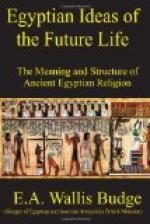The fact of the existence of two versions of this remarkable Chapter proves that the composition is much older than the papyrus [Footnote: About B.C. 300.] in which it is found, and the variant readings which occur in each make it certain that the Egyptian scribes had difficulty in understanding what they were writing. It may be said that this version of the cosmogony is incomplete because it does not account for the origin of any of the gods except those who belong to the cycle of Osiris, and this objection is a valid one; but in this place we are only concerned to shew that R[=a], the Sun-god, was evolved from the primeval abyss of water by the agency of the god Khepera, who brought this result about by pronouncing his own name. The great cosmic gods, such as Ptah and Khnemu, of whom mention will be made later, are the offspring of another set of religious views, and the cosmogony in which these play the leading parts is entirely different. We must notice, in passing, that the god whose words we have quoted above declares that he evolved himself under the form, of Khepera, and that his name is Osiris, “the primeval matter of primeval matter,” and that, as a result, Osiris is identical with Khepera in respect of his evolutions and new births. The word rendered “evolutions” is kheperu, literally “rollings”; and that rendered “primeval matter” is paut, the original “stuff” out of which everything was made. In both versions we are told that men and women came into being from the tears which fell from the “Eye” of Khepera, that is to say from the Sun, which, the god says, “I made take to up its place in my face, and afterwards it ruled the whole earth.”
We have seen how R[=a] has become the visible type and symbol of God, and the creator of the world and of all that is therein; we may now consider the position which he held with, respect to the dead. As far back as the period of the IVth dynasty, about B.C. 3700, he was regarded as the great god of heaven, and the king of all the gods, and divine beings, and of the beatified dead who dwelt therein. The position of the beatified in heaven is decided by R[=a], and of all the gods there Osiris only appears to have the power to claim protection for his followers; the offerings which the deceased would make to R[=a] are actually presented to him by Osiris. At one time the Egyptian’s greatest hope seems to have been that he might not only become “God, the son of God,” by adoption, but that R[=a] would become actually his father. For in the text of Pepi




